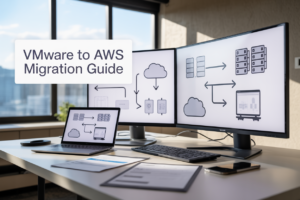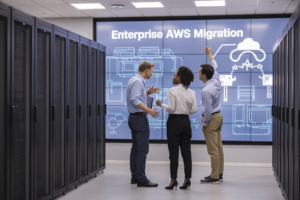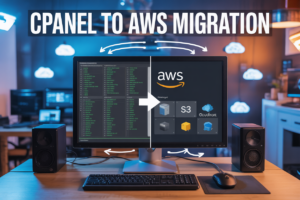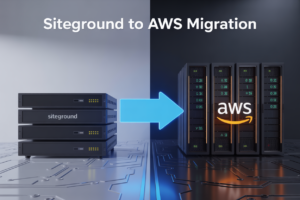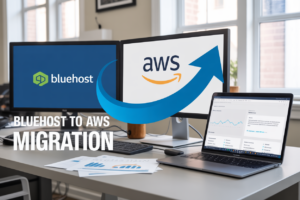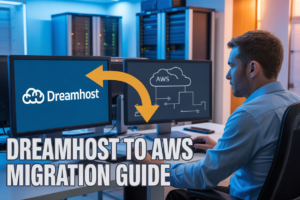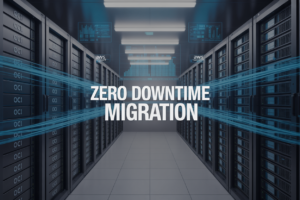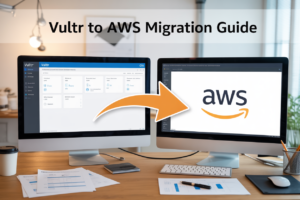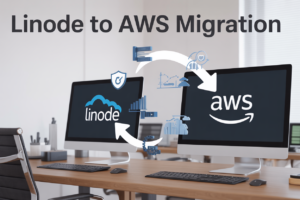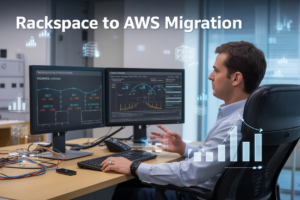Moving your AWS infrastructure away from public internet routing doesn’t have to be complicated. AWS VPC endpoints offer a straightforward path to enhance your cloud security implementation while keeping traffic within Amazon’s private network backbone.
This guide is designed for cloud engineers, DevOps teams, and security professionals who want to strengthen their AWS network security without the complexity of traditional VPN setups or NAT gateway dependencies. You’ll learn practical approaches to VPC endpoint configuration that reduce attack surfaces and improve compliance posture.
We’ll walk through the fundamentals of AWS private connectivity and help you recognize the specific scenarios where VPC endpoints deliver the most value for your organization. You’ll get hands-on guidance for gateway endpoints setup and interface endpoints AWS configuration, complete with real-world examples. Finally, we’ll cover VPC security best practices and tackle common VPC endpoint troubleshooting scenarios that teams encounter during implementation.
By the end, you’ll have a clear roadmap for implementing private cloud connectivity that aligns with your security requirements and operational needs.
Understanding AWS VPC Endpoints and Their Security Benefits
What Are VPC Endpoints and How They Enhance Network Security
AWS VPC endpoints create secure, private connections between your Virtual Private Cloud and AWS services without routing traffic through the public internet. These endpoints act as virtual devices that allow your EC2 instances to communicate directly with services like S3, DynamoDB, and Lambda through Amazon’s internal network backbone. By keeping data within AWS’s private infrastructure, VPC endpoints eliminate exposure to internet-based threats, reduce attack vectors, and provide better compliance with regulatory requirements. Your sensitive workloads gain an additional security layer since traffic never leaves the AWS network perimeter, making it invisible to potential attackers monitoring public internet connections.
Key Differences Between Gateway and Interface Endpoints
Gateway endpoints work as route table entries that redirect traffic destined for specific AWS services through a secure pathway, currently supporting only S3 and DynamoDB. These endpoints don’t require additional network interfaces or IP addresses within your VPC subnets. Interface endpoints, powered by AWS PrivateLink technology, create Elastic Network Interfaces with private IP addresses in your chosen subnets, supporting a broader range of AWS services including EC2, SNS, SQS, and many others. While gateway endpoints handle routing automatically through your VPC’s route tables, interface endpoints require DNS resolution configuration and can be accessed from on-premises networks through VPN or Direct Connect connections.
Cost Savings Through Reduced Data Transfer Charges
VPC endpoint configuration eliminates costly NAT Gateway data processing charges when accessing AWS services from private subnets. Traditional architectures requiring internet gateways incur data transfer fees for outbound traffic, especially when downloading large objects from S3 or processing high-volume DynamoDB operations. Gateway endpoints provide free data transfer for S3 and DynamoDB, while interface endpoints charge only for the endpoint hours and data processing, often resulting in significant savings for data-intensive applications. Organizations typically see 60-80% reduction in data transfer costs when implementing VPC endpoints for their most frequently accessed AWS services.
Eliminating Internet Gateway Dependencies for Better Control
VPC endpoints remove the requirement for internet gateways in private subnet architectures, creating truly isolated environments for sensitive workloads. Your applications can access AWS services without maintaining complex NAT gateway configurations or managing security groups that allow outbound internet access. This architectural approach strengthens your security posture by reducing the number of potential entry points into your network infrastructure. Private cloud connectivity through VPC endpoints ensures that even if your internet gateway experiences issues or gets compromised, your critical AWS service integrations continue operating seamlessly through the internal AWS network.
Identifying When Your Organization Needs VPC Endpoints
High Data Transfer Costs Between VPC and AWS Services
When your monthly AWS bill shows significant data transfer charges for communication between your VPC and services like S3 or DynamoDB, AWS VPC endpoints become a smart financial decision. Without VPC endpoints, traffic flows through your NAT gateway and internet gateway, generating costly data transfer fees. Organizations processing large datasets or running data-intensive applications often see hundreds or thousands of dollars in unnecessary charges monthly. VPC endpoint configuration eliminates these costs by creating direct connections to AWS services within Amazon’s network backbone, bypassing internet routing entirely.
Strict Compliance Requirements for Network Traffic Isolation
Industries like healthcare, finance, and government face stringent compliance mandates requiring complete network traffic isolation. Private cloud connectivity through VPC endpoints ensures sensitive data never traverses the public internet when accessing AWS services. This AWS network security approach satisfies regulatory frameworks like HIPAA, PCI DSS, and FedRAMP by maintaining data sovereignty within controlled network boundaries. Compliance auditors specifically look for documented network isolation controls, making VPC endpoints essential infrastructure components for regulated environments.
Performance Issues with Internet-Based AWS Service Access
Applications experiencing latency spikes or inconsistent response times when accessing AWS services often benefit from AWS private connectivity. Internet-based connections introduce variable routing paths, network congestion, and potential bandwidth limitations that affect application performance. VPC endpoints provide predictable, low-latency connections by routing traffic through Amazon’s optimized internal network. Database applications, real-time analytics platforms, and high-frequency trading systems particularly benefit from the reduced network hops and improved reliability that gateway endpoints setup and interface endpoints deliver.
Step-by-Step Implementation Guide for Gateway Endpoints
Setting Up S3 Gateway Endpoints for Secure Storage Access
Gateway endpoints for S3 create a direct, private connection between your VPC and Amazon S3 without requiring internet gateways or NAT devices. Create the endpoint through the VPC console by selecting your VPC, choosing the S3 service, and specifying route tables that should receive the endpoint routes. Configure your bucket policies to restrict access only from your VPC endpoint using the aws:sourceVpce condition key. This setup ensures S3 traffic remains within AWS’s private network, reducing data transfer costs and eliminating exposure to public internet threats.
- Navigate to VPC Dashboard > Endpoints > Create Endpoint
- Select “Gateway” type and choose “com.amazonaws.region.s3”
- Associate with specific route tables where S3 access is needed
- Update bucket policies to enforce VPC endpoint access only
- Test connectivity using AWS CLI commands from EC2 instances
Configuring DynamoDB Gateway Endpoints for Database Security
DynamoDB gateway endpoints work similarly to S3 endpoints, providing private connectivity to your DynamoDB tables without internet routing. The configuration process involves creating a gateway endpoint for DynamoDB service and updating route tables to direct DynamoDB traffic through the endpoint. Apply IAM policies and resource-based policies to control which VPC resources can access specific DynamoDB tables. Monitor endpoint usage through VPC Flow Logs and CloudTrail to track database access patterns and ensure compliance with security requirements.
- Create gateway endpoint for “com.amazonaws.region.dynamodb”
- Select appropriate route tables for DynamoDB traffic routing
- Configure IAM policies with VPC endpoint conditions
- Set up DynamoDB resource policies for additional access control
- Enable logging for security monitoring and compliance tracking
Managing Route Tables and Security Groups Effectively
Route table management becomes critical when implementing gateway endpoints since these endpoints automatically add routes for AWS services to your specified route tables. Review existing routes before endpoint creation to avoid conflicts with custom routing configurations. Security groups don’t directly control gateway endpoint traffic since it operates at the route table level, but they still govern access between your instances and the services. Regular auditing of route propagation and endpoint policies ensures your AWS VPC endpoint configuration maintains security while providing efficient private connectivity to AWS services.
- Audit existing routes before creating gateway endpoints to prevent conflicts
- Document which route tables are associated with each gateway endpoint
- Monitor route propagation using VPC console and AWS CLI tools
- Implement least-privilege access through endpoint and IAM policies
- Set up CloudWatch alarms for unusual endpoint traffic patterns
Implementing Interface Endpoints for Enhanced Service Integration
Creating Interface Endpoints for EC2 and Lambda Services
Interface endpoints enable secure, private connectivity between your VPC and AWS services without traversing the public internet. Start by navigating to the VPC console and selecting “Endpoints” from the sidebar. Choose “Create Endpoint” and select “Interface” as the endpoint type. For EC2 services, select the com.amazonaws.region.ec2 service name, while Lambda requires com.amazonaws.region.lambda. Specify your target VPC and select the appropriate subnets across multiple Availability Zones for redundancy. The interface endpoint creates Elastic Network Interfaces (ENIs) in your selected subnets, providing dedicated IP addresses for service communication. Configure security groups to control traffic flow, ensuring only authorized resources can access the endpoint. Interface endpoints support various AWS services including EC2, Lambda, S3, and many others, creating a comprehensive private cloud connectivity solution.
Configuring DNS Resolution for Seamless Application Integration
DNS resolution configuration ensures your applications can seamlessly connect to AWS services through VPC endpoints without code modifications. Enable private DNS names when creating interface endpoints to automatically route service calls through your VPC endpoint configuration. This feature modifies DNS resolution within your VPC, redirecting standard AWS service DNS names to your private endpoint addresses. Your applications continue using standard AWS SDK calls and service URLs while traffic flows through the secure private connection. For custom DNS scenarios, you can manually configure DNS records pointing to the endpoint’s private IP addresses. Route 53 Resolver can handle complex DNS routing scenarios, especially in hybrid environments. Test DNS resolution using tools like nslookup or dig to verify that service names resolve to your endpoint’s private IP addresses rather than public AWS IP ranges.
Setting Up Network Load Balancers for High Availability
Network Load Balancers enhance interface endpoint availability and performance by distributing traffic across multiple endpoint network interfaces. AWS automatically provisions Network Load Balancers for interface endpoints when you select multiple Availability Zones during creation. The load balancer operates at Layer 4, providing ultra-low latency and high throughput for your VPC endpoint connections. Configure health checks to ensure traffic only routes to healthy endpoint interfaces, maintaining service reliability even during maintenance or failures. Cross-zone load balancing distributes traffic evenly across all healthy targets in all enabled Availability Zones. Monitor load balancer metrics through CloudWatch to track connection counts, target health, and performance statistics. For applications requiring consistent connections, enable connection persistence features. The Network Load Balancer automatically handles DNS resolution, providing a single endpoint address that resolves to healthy interface IP addresses.
Managing Elastic Network Interfaces and IP Addressing
Elastic Network Interfaces serve as the foundation for interface endpoints, requiring careful IP addressing and network management. Each interface endpoint creates ENIs in your specified subnets, consuming private IP addresses from your VPC’s address space. Plan subnet capacity carefully, ensuring adequate IP address availability for current and future endpoint requirements. ENIs inherit security group configurations, controlling traffic flow at the network level. Monitor ENI status through the EC2 console, checking for attachment states and network connectivity issues. Secondary IP addresses can be assigned to ENIs for specific routing requirements or application needs. Consider IP address management strategies, especially in large environments with multiple endpoints across numerous subnets. Document ENI locations and associated services for troubleshooting and maintenance purposes. Use VPC Flow Logs to monitor traffic patterns and identify connectivity issues with specific ENIs.
Security Best Practices and Access Control Strategies
Implementing Endpoint Policies for Granular Permission Control
Endpoint policies act as guardians for your AWS VPC endpoints, letting you define exactly who can access what services and under which conditions. These JSON-based policies work like IAM policies but specifically control traffic flowing through your VPC endpoints. You can restrict access based on principals, actions, resources, and conditions – creating multiple layers of security. For example, you might allow only specific IAM roles to access S3 through your gateway endpoint, or restrict DynamoDB access to certain table operations during business hours. The beauty lies in combining endpoint policies with resource-based policies and IAM permissions for defense-in-depth security.
Monitoring VPC Endpoint Traffic with CloudTrail and VPC Flow Logs
Visibility into your VPC endpoint traffic is non-negotiable for maintaining strong cloud security implementation. CloudTrail captures API calls made through your endpoints, showing you which services are being accessed, by whom, and when. VPC Flow Logs complement this by recording network-level information about traffic flowing to and from your interface endpoints. Set up custom log filters to catch unusual patterns or unauthorized access attempts. Consider streaming these logs to CloudWatch for real-time monitoring and automated alerting. This combination gives you complete audit trails and helps meet compliance requirements while identifying potential security incidents before they escalate.
Securing Endpoint Communications with Encryption Standards
Your VPC endpoint communications must maintain the same encryption standards as direct AWS service connections. All traffic between your VPC and AWS services through interface endpoints uses TLS 1.2 encryption by default. For gateway endpoints accessing S3 and DynamoDB, encryption depends on how you configure your client applications – always enable SSL/TLS connections in your code. Apply encryption at rest for any data stored through these endpoints using AWS KMS keys. Don’t forget about certificate validation – your applications should verify SSL certificates to prevent man-in-the-middle attacks. These encryption layers ensure your data stays protected throughout its journey.
Managing Cross-Account Access Through Resource-Based Policies
Cross-account access through VPC endpoints requires careful orchestration of resource-based policies and endpoint configurations. Start by configuring your interface endpoints to accept connections from trusted AWS accounts using endpoint policies. The target service’s resource-based policy must explicitly allow access from your VPC endpoint or the requesting principals. For S3 bucket policies, include conditions that specify your VPC endpoint ID to ensure requests only come through approved paths. Cross-account Lambda function access through VPC endpoints needs both the function’s resource-based policy and your endpoint policy aligned. Test these configurations thoroughly since misaligned policies can create access gaps or unintended permissions.
Troubleshooting Common VPC Endpoint Implementation Challenges
Resolving DNS Resolution Issues in Private Subnets
DNS resolution problems often surface when resources in private subnets can’t reach AWS services through VPC endpoints. Enable DNS hostnames and DNS resolution in your VPC settings – both must be active for interface endpoints to work correctly. Private DNS names won’t resolve without these settings enabled. Check your DHCP options set includes the AmazonProvidedDNS resolver. For custom DNS servers, configure conditional forwarding for AWS service domains to the VPC resolver. Test connectivity using nslookup or dig commands to verify DNS queries resolve to the VPC endpoint’s private IP addresses rather than public AWS service IPs.
Fixing Connectivity Problems with Security Group Configurations
Security group misconfigurations block traffic to VPC endpoints despite correct DNS resolution. Interface endpoints require inbound rules allowing HTTPS traffic (port 443) from your resources’ security groups or CIDR blocks. The default security group attached to interface endpoints often blocks necessary traffic. Create dedicated security groups for VPC endpoints with specific inbound rules matching your application requirements. Gateway endpoints bypass security groups entirely since they use route table modifications. Always verify your resources’ outbound rules permit traffic to the VPC endpoint’s security group or IP ranges.
Addressing Performance Bottlenecks and Bandwidth Limitations
Performance issues with VPC endpoint troubleshooting typically stem from insufficient endpoint capacity or suboptimal configurations. Interface endpoints share bandwidth across all consumers in your VPC, creating potential bottlenecks during peak usage. Deploy multiple interface endpoints across different Availability Zones to distribute traffic load and improve resilience. Monitor CloudWatch metrics for VPC endpoints to identify bandwidth saturation or high latency patterns. Consider the endpoint’s ENI limitations – each interface endpoint supports specific throughput limits based on instance types hosting the network interfaces. Gateway endpoints generally offer better performance for S3 and DynamoDB since they don’t introduce additional network hops.
AWS VPC endpoints offer a powerful way to secure your cloud infrastructure while keeping costs manageable. By keeping traffic within the AWS network, you eliminate the security risks that come with internet routing and avoid unnecessary data transfer charges. The key is knowing when you actually need them – like when you’re handling sensitive data, dealing with compliance requirements, or managing high-volume workloads that would benefit from reduced latency.
Getting VPC endpoints up and running doesn’t have to be complicated. Start with gateway endpoints for S3 and DynamoDB since they’re free and provide immediate security benefits. Then consider interface endpoints for other services based on your specific needs and traffic patterns. Remember to set up proper security groups, route tables, and policies from the start – it’s much easier than fixing security gaps later. Take the time to plan your endpoint strategy now, and you’ll save yourself headaches down the road while building a more secure, cost-effective cloud environment.











